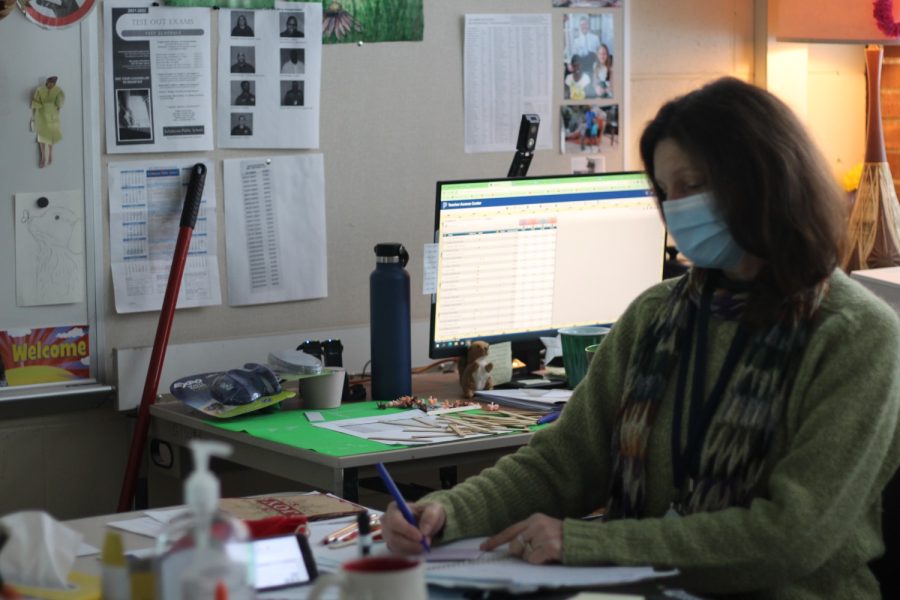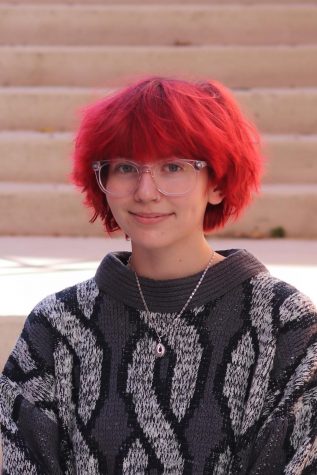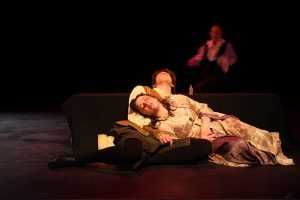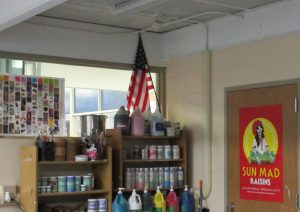The road to Loy Norrix: Staff members speak on their history in education
Credit: Milo Turner
Teacher Christina Holmes jots down a note on her lunch break. Holmes often allows Spanish course students to eat in her room during the hour.
January 26, 2022
According to a 2021 survey from the nonprofit research organization, RAND, almost one in four American teachers said that they were likely to quit their job. Now more than ever, there is a higher demand for educators.
KPS students are now being given the opportunity to enroll in programs like the Kalamazoo RESA Teacher Academy, volunteer to tutor younger age groups through Read And Write Kalamazoo and attend a variety of different education-based courses at KVCC through dual enrollment.
These programs suggest that younger people are getting interested in the teaching field.
Fortunately for students who someday hope to work in an environment like Loy Norrix, staff members have opened up about their education and careers before employment and offered advice.
Counselor Rebecca Learner saw herself taking a variety of different paths before going into counseling.
“I didn’t know what career I wanted to pursue after graduating from high school. Some of my favorite classes in high school were biology, journalism, physics, music, and drama,” Learner said. “I thought it would be interesting to be a scientific writer, music therapist, psychiatrist, teacher or documentary filmmaker.”
Learner attended the University of Michigan after high school, and even through college, counseling was not an obvious option.
Learner said, “I didn’t declare my major until the end of my sophomore year. I enjoyed being a liberal arts student and taking classes that interested me and trying new subjects. I worked part-time in the math library and dorm cafeteria, volunteered at a middle school, played in the university orchestra and in the pit orchestra for the musicals and was a board member for the U of M Student Government.”
It’s not uncommon for college students today to switch courses in declaring or changing their majors.
A study conducted by the US Department of Education found that between 2012 and 2014, 1 in 10 undergraduates changed their major more than once.
At the end of her sophomore year, Learner transferred from the university’s Literature, Science and Arts program to the School of Education and majored in Early Childhood Development.
After earning a Bachelor of Arts Degree, Learner pursued a Master’s degree in Counselor Education and Counseling Psychology at Western Michigan University, which drew her to Kalamazoo in 1984.
“I received my master’s degree and Professional Counseling License in 1988. In the 1980’s, students working on a school counseling degree were required to have a teaching certificate. This is no longer a requirement,” Learner added.
As a word of advice to students who want to eventually work in a similar position, Learner said, “Students who think they may be interested in becoming a counselor should come and talk with their school counselor to learn more about the job. In addition to school counseling, there are community, clinical, family, and child counseling opportunities. It helps to be curious, creative, and optimistic. Counseling is a solution-focused occupation and you should enjoy working with people. Counselors don’t have all of the answers, rather, they help others find the answer.”
Like Learner, Erin Anderson, Loy Norrix’s Dean of Students, attended counseling-based courses.
Out of high school, Anderson attended Indiana State University in Terre Haute, Indiana.
“After two years, I transferred to Ball State University where I graduated with my bachelor’s degree in psychology and a minor in human growth and development,” Anderson said.
Before coming to Kalamazoo as a counselor at Kalamazoo Central, Anderson worked as an investigator with Child Protective Services for the State of Indiana.
“I would encourage a student who wishes to join the field of education in some capacity to have conversations with people currently in the role, shadow them if possible,” Anderson recommended. “Education is complex, with many layers to find a fit that may be best for you if you want to help kids.”
For students who are looking for a less traditional entry into the workforce, there are many opportunities to use skills they’ve already honed in on, such as language fluency and translation skills.
Today, Christina Holmes teaches Spanish II, Spanish III and AP Spanish courses, but Holmes studied vastly different subjects in the past.
In discussing her path to becoming a teacher, Holmes said, “My bachelor’s degree is in film studies, and I really wanted to make documentaries. That was sort of my goal. But then, I moved from Detroit to Kalamazoo and discovered that it’s really hard to be in that industry and survive, and eat, and have an apartment, so I ended up using my Spanish to get connected with the Hispanic American Council and I volunteered there teaching English classes.”
Holmes continued, “I thought I knew what I wanted to do, but then reality set in and it sort of led me on a different path.”
It was after moving to New York City and working in the entertainment industry that Holmes decided to start seriously pursuing the teaching field.
“I didn’t feel fulfilled when working in TV because it’s all sort of fluffy, you know, it’s just entertainment. I wasn’t working on documentaries or anything, I was just working on TV shows and films, so I ended up deciding that maybe teaching would be better, and then I could use my Spanish as well,” Holmes explained.
Holmes’ time in the city drew her to Michigan again, as she had previously been enrolled at Western Michigan University before attending Brooklyn College.
“Through this program in New York, they just make you teach while getting your master’s degree, so I ended up teaching at a middle school in Brooklyn,” Holmes continued. “I was teaching Spanish while I was getting my master’s degree, and I was pregnant at the same time, so Sophia was born, I got my masters’ degree, I had two years under my belt, and life led me back to Michigan. It was just a natural fit to try to find a language position, and then I ended up here.”
Holmes reflected, “This is my third career. I love teaching and I love being with students, but I do have lots of other interests. I’d love to be in the medical field, and I’ve worked as a translator, but it might be fun to dive into that permanently, later in my retirement. Who knows? Maybe I’ll work at a flower shop, I don’t know, but it would be cool to let life lead me into some other path once I retire from teaching.”












